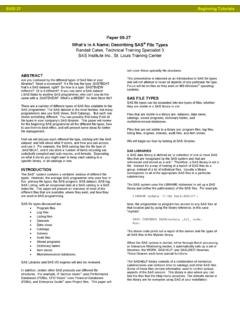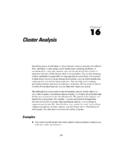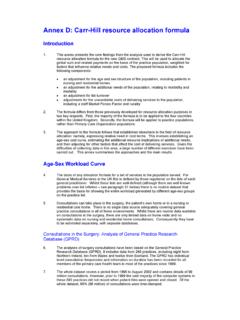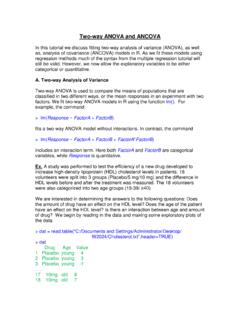Transcription of 242-30: Arrays Made Easy: An Introduction to …
1 1 Paper 242-30 Arrays made easy : An Introduction to Arrays and array ProcessingSteve First and Teresa Schudrowitz, Systems Seminar Consultants, Inc., Madison, WIABSTRACTMany programmers often find the thought of using Arrays in their programs to be a daunting task, and as a result theyoften shy away from Arrays in their code in favor of better-understood, but more complex solutions. A SAS array is aconvenient way of temporarily identifying a group of variables for processing within a data step. Once the array hasbeen defined the programmer is now able to perform the same tasks for a series of related variables, the arrayelements. Once the basics of array processing are understood Arrays are a simple solution to many this paper we will review the following array topics:1) Why do we need Arrays ?2) Basic array conceptsa) Definitionb) Elementsc) Syntaxd) Rules3) Using array indexes4) One dimension arrays5) Multi-dimension arrays6) Temporary arrays7) Explicit vs.
2 Implicit subscripting8) Sorting arrays9) When to use arrays10) Common errors and misunderstandingsINTRODUCTIONMost mathematical and computer languages have some notation for repeating or other related values. Theserepeated structures are often called a matrix, a vector, a dimension, a table, or in the SAS data step, this structure iscalled an array . While every memory address in a computer is an array of sorts, the SAS definition is a group ofrelated variables that are already defined in a data step. Some differences between SAS Arrays and those of otherlanguages are that SAS array elements don t need to be contiguous, the same length, or even related at all. Allelements must be character or DO WE NEED Arrays ?The use of Arrays may allow us to simplify our processing. We can use Arrays to help read and analyze repetitivedata with a minimum of array and a loop can make the program smaller. For example, suppose we have a file where each record contains24 values with the temperatures for each hour of the day.
3 These temperatures are in Fahrenheit and we need toconvert them to 24 Celsius values. Without Arrays we need to repeat the same calculation for all 24 temperaturevariables:data; input etc. celsius_temp1 = 5/9(temp1 32); celsius_temp2 = 5/9(temp2 32); .. celsius_temp24 = 5/9(temp24 32);run; SUGI 30 Tutorials2An alternative is to define Arrays and use a loop to process the calculation for all variables:data; input etc. array temperature_array {24} temp1-temp24; array celsius_array {24} celsius_temp1-celsius_temp24; do i = 1 to 24; celsius_array{i} = 5/9(temperature_array{i} 32); end;run;While in this example there are only 24 elements in each array , it would work just as well with hundreds of addition to simplifying the calculations, by defining Arrays for the temperature values we could also have used themin the input statement to simplify the input process. It should also be noted, while TEMP1 is equivalent to the firstelement, TEMP2 to the second etc.
4 , the variables do not need to be named consecutively. The array would work justas well with non-consecutive variable sample_array {5} x a i r d;In this example, the variable x is equivalent to the first element, a to the second may also be used to provide table lookups. For instance, we have different percentage rates that will beapplied to a representative s sales amounts to determine their commission. The percentage amount may be storedwithin an array structure, and then the array could provide a location to look up the appropriate percentage forinclusion in the commission array CONCEPTSA rrays within SAS are different than Arrays in other languages. SAS Arrays are another way to temporarily group andrefer to SAS variables. A SAS array is not a new data structure, the array name is not a variable, and Arrays do notdefine additional variables. Rather, a SAS array provides a different name to reference a group of array statement defines variables to be processed as a group.
5 The variables referenced by the array arecalled elements. Once an array is defined, the array name and an index reference the elements of the array . Sincesimilar processing is generally completed on the array elements, references to the array are usually found within STATEMENTThe statement used to define an array is the array array -name {n} <$> <length> array -elements <(initial-values)>;The array statement is a compiler statement within the data step. In addition, the array elements cannot be usedin compiler statements such as DROP or KEEP. An array must be defined within the data step prior to beingreferenced and if an array is referenced without first being defined, an error will occur. Defining an array within onedata step and referencing the array within another data step will also cause errors, because Arrays exist only for theduration of the data step in which they are defined. Therefore, it is necessary to define an array within every datastep where the array will be referencedThe array statements provides the following information about the SAS array : array -name Any valid SAS name n Number of elements within the array $ - Indicates the elements within the array are character type variables length A common length for the array elements elements List of SAS variables to be part of the array initial values Provides the initial values for each of the array elementsThe array name will be used as part of the array reference when the array elements are used in processing.
6 Thename must follow the same rules as variable names, therefore, any valid SAS name is a valid array name. Whennaming an array it is best to avoid using an array name that is the same as a function name to avoid parentheses or square brackets can be used when referencing array elements, the braces {} are used mostoften since they are not used in other SAS statements. SAS does place one restriction on the name of the array name may not be the same name as any variable on the SAS data set. SUGI 30 Tutorials3 The elements for an array must be all numeric or all character. When the elements are character it is necessary toindicate this at the time the array is defined by including the dollar sign ($) on the array statement after the referenceto the number of elements. If the dollar sign is not included on the array statement, the array is assumed to all numeric or all character variables in the data set are to be elements within the array , there are severalspecial variables that may used instead of listing the individual variables as elements.
7 The special variables are:_NUMERIC_ - when all the numeric variables will be used as elements_CHARACTER_ - when all the character variables will be used as elements_ALL_ - when all variables on the data set will be used as elements and the variables are allthe same typeN is the array subscript in the array definition and it refers to the number of elements within the array . A numericconstant, a variable whose value is a number, a numeric SAS expression, or an asterisk (*) may be used as thesubscript. The subscript must be enclosed within braces {}, square brackets [], or parentheses (). In our temperatureexample the subscript will be 24 for each of the 24 temperature variables: array temperature_array {24} temp1 temp24;When the asterisk is used, it is not necessary to know how many elements are contained within the array . SAS willcount the number of elements for you. An example of using the asterisk is when one of the special variables definesthe allnums {*} _numeric_;When it is necessary to know how many elements are in the array , the DIM function can be used to return the countof i = 1 to dim(allnums); allnums{i} = round(allnums{i}.)
8 1);end;In this example, when the array ALLNUMS is defined, SAS will count the number of numeric variables used aselements of the array . Then, in the DO group processing, the DIM function will return the count value as the endingrange for the REFERENCESWhen an array is defined with the array statement SAS creates an array reference. The array reference is in thefollowing form: array -name{n}The value of n will be the element s position within the array . For example, in the temperature array defined abovethe temperature for 1:00 PM is in the variable TEMP13. The array element has been assigned the 13th position withinthe array . Therefore, the array reference will be:temperature_array{13} The variable name and the array reference are interchangeable. When an array has been defined in a data stepeither the variable name or the array reference may be NameArray Referencetemp1temperature_array{1}temp2t emperature_array{2}temp3temperature_arra y{3}temp4temperature_array{4}temp5temper ature_array{5}An array reference may be used within the data step in almost any place other SAS variables may be used includingas an argument to many SAS functions.
9 If the data step does not have an array statement to define the array andcreate the array reference, errors will occur. When an array is referenced within a data step, it must be defined withan array statement in the same data step. SUGI 30 Tutorials4 USING array INDEXESThe array index is the range of array elements. In our temperature example, we are looking at temperatures for eachof the 24 hours of the day. The array is defined as: array temperature_array {24} temp1 temp24;Another variation in SAS Arrays from Arrays within other languages is, subscripts are 1-based by default where arraysin other languages may be 0-based. When we set the array bounds with the subscript and only specify the number ofelements within the array as our upper bound, the lower bound is the default value of 1. In our example, the indexbegins with the lower bound of 1 and ends with the upper bound of may be scenarios when we want the index to begin at a lower bound other than 1.
10 This is possible bymodifying the subscript value when the array is defined. For this example we are using our same temperaturevariables. Only this time we only want the temperatures for the daytime, temperatures 6 through 18. In this examplethe array is defined as: array temperature_array {6:18} temp6 temp18;The subscript will be written as the lower bound and upper bound of the range, separated by a technique can simplify array usage by using natural values for the index. Examples of this might be to use aperson s age, or to use a year value to get to the correct DIMENSION ARRAYSA simple array may be created when the variables grouped together conceptually appear as a single row. This isknown as a one-dimensional array . Within the Program Data Vector the variable structure may be visualized as:temperature_array{1}{2}{3}{4}{5}..{24 }Temperature array statement to define this one-dimensional array will be: array temperature_array {24} temp1 temp24;The array has 24 elements for the variables TEMP1 through TEMP24.

















